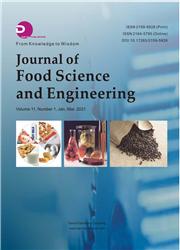The Effect of Different Chemical Agents on the Prevention of Enzymatic Browning in Banana
引用次数: 10
Abstract
This study was conducted to test the concept of fresh cut banana slices with the effects of chemical treatments on the surface appearance and selected quality indexes of banana samples right after cutting and during 2-week of storage at refrigeration conditions (0-4 °C). Banana slices were treated with an ascorbic acid, sodium chloride, citric acid, calcium chloride, and sodium carbonate, water (room temperature), and hot water (65 °C). Quality attributes, e.g. color, PPO (polyphenol oxidase) activities, surface appearance of the cut bananas were compared. Banana slices immersed in sodium chloride, calcium chloride, citric acid and sodium ascorbate showed visual traces of browning during storage at 4 °C. After 14 days of storage, only ascorbic acid treated banana samples showed moderate browning, while all other treatments were severely affected. Browning was more severe for the samples immersed in water for all storage times. The browning measurement (a value) became increasingly positive from first to fourteenth day storage. It was observed that the inactivation of PPO enzyme was achieved for the ascorbic acid treated sample most. Rather than ascorbic acid treatment, cut banana samples showed less PPO enzyme activity for sodium chloride, citric acid, calcium chloride, sodium carbonate, hot water, and water (room temperature) treatments, subsequently. There were no significant changes observed on the different chemical treatments (sodium chloride, citric acid, calcium chloride, and sodium carbonate) except ascorbic acid. In overall, ascorbic acid was found to be the most efficient treatment on the inactivation of PPO enzyme activity among all the treatments. Beside the inactivation of the enzyme, ascorbic acid showed a better success to prevent color degradation of bananas. This study showed that ascorbic acid treatment is an effective chemical agent on the inactivation of browning enzymes.不同化学药剂对香蕉酶促褐变的防治作用
本研究旨在测试新鲜香蕉切片的概念,以及化学处理对香蕉切片后和冷藏条件下(0-4°C)储存2周期间香蕉样品表面外观和选定质量指标的影响。香蕉片用抗坏血酸、氯化钠、柠檬酸、氯化钙和碳酸钠、水(室温)和热水(65°C)处理。比较了香蕉切片的颜色、多酚氧化酶活性、表面形貌等品质指标。浸泡在氯化钠、氯化钙、柠檬酸和抗坏血酸钠中的香蕉片在4°C的储存过程中显示出明显的褐变痕迹。储存14天后,只有抗坏血酸处理的香蕉样品表现出中度褐变,而所有其他处理都受到严重影响。在所有储存时间内,浸泡在水中的样品的褐变更加严重。褐变测量值(a值)从储存的第一天到第十四天变得越来越正。观察到,对于抗坏血酸处理的样品,PPO酶的失活最多。与抗坏血酸处理不同,香蕉切片样品随后对氯化钠、柠檬酸、氯化钙、碳酸钠、热水和水(室温)处理显示出较少的PPO酶活性。除抗坏血酸外,不同的化学处理(氯化钠、柠檬酸、氯化钙和碳酸钠)没有观察到显著变化。总的来说,抗坏血酸被发现是所有处理中对PPO酶活性失活最有效的处理。抗坏血酸除了能使酶失活外,还能更好地防止香蕉的颜色降解。本研究表明,抗坏血酸处理是一种有效的褐变酶灭活剂。
本文章由计算机程序翻译,如有差异,请以英文原文为准。
求助全文
约1分钟内获得全文
求助全文

 求助内容:
求助内容: 应助结果提醒方式:
应助结果提醒方式:


